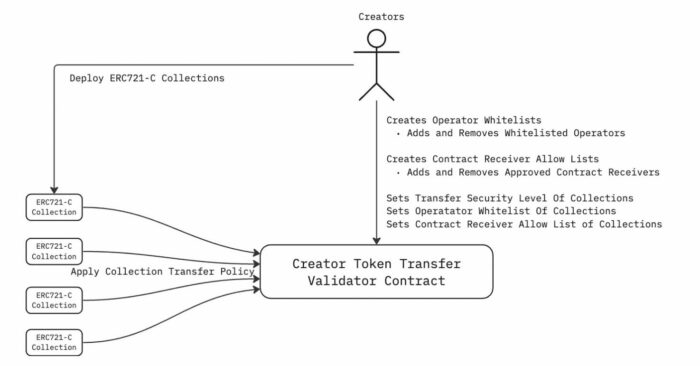What Is ERC721-C, and Could It Solve Web3’s Royalty Issues?
Creator royalties have become a major point of contention in the NFT space. This shouldn’t be news to anyone who claims Web3 as their stomping ground. But what should be surprising is that the debate surrounding the necessity of royalties has failed to make any truly significant progress since its inception.
Sure, most of the NFT space’s most prominent marketplaces have taken a stance on the matter. Still, by and large, innovations like Manifold’s Royalty Registry have fallen short of ensuring creators receive their dues. That isn’t to say there aren’t builders actively trying to remedy the situation though. There surely are, and the recently announced ERC721-C standard is undoubtedly proof of such efforts.
What is ERC721-C?
ERC721-C is a new type of token standard created to effectively make on-chain royalties enforceable. In contrast with ERC-721 and ERC1155 — the most commonly created and traded type of NFTs — this new standard makes royalties programmable, allowing creators to block zero-fee exchanges from platforming their works once and for all.
Conceived by blockchain gaming company Limit Break, ERC721-C (and ERC1155-C) allow creators to set new rules for their royalties on-chain. In simple terms, this new standard means artists and developers can create a sort of permissioned smart contract that dictates where and how royalties are transferred.
Essentially, this new type of customizable royalties contract allows creators to choose where their NFTs are sold and empowers them to filter interactions from only the contracts and applications of their choosing. No longer will traders be able to circumvent royalties by using zero-fee platforms because any collection created with ERC721-C can simply opt out of trading on such marketplaces.
How might ERC721-C be used?
Limit Break’s new advent can also be applied to a variety of use cases other than simple end-to-end royalty transactions. As noted by strategist and writer Hunter Solaire in his tweets below, users of this new standard could easily find dynamic ways to customize their royalties to benefit themselves and their supporters.
Now you can:
Give them the royalties for the first 10 sales
Set royalties to 0% if the NFTs trade under the mint price
Give them 1-100% of future royalties on the NFT they minted
Another one
7/13 pic.twitter.com/want3MOSbY
— Hunter Solaire ᵍᵐ (@huntersolaire_) May 15, 2023
Not all holders are equal:
Some buy to flip or hold in silence
Others buy, turn it into their identity and fight for your brand every day
Now you can reward your most valuable community members or DAOs with a royalty % on NFTs with specific traits or rarities
9/13 pic.twitter.com/C1F5zBrFGd
— Hunter Solaire ᵍᵐ (@huntersolaire_) May 15, 2023
ERC721-C could potentially even be used for community-building initiatives, as royalties from sales could be automatically split between, say, members of a DAO or winners of a contest. But instead of kickbacks happening in perpetuity, creators can allocate what percentages are doled out, when, and how frequently.
Moreover, ERC721-C is built to be fully backward compatible, meaning it will function without issue with existing chain and marketplace standards. About this specific functionality, the CEO of Limit Break, Gabriel Leydon, expressed his excitement during a Twitter Space by saying, “You will actually be able to block exchanges for real now, and there’s nothing they can do about it.”
“The standard that everybody’s using right now cannot defend royalties,” Leydon added. “This is the real deal. This is a real on-chain solution for royalties. This will work, it’s going to work, and in my opinion, it’s going to change the internet.”
When will ERC721-C be in action?
An important consideration to be made with ERC721-C and ERC1155-C (or other new standards like ERC-6551 or BRC-20, for that matter) is that they won’t be adopted overnight. Although interest has been steadily spreading throughout the NFT space, the standard is new and relatively complex and might become further compounded if more features are added.

Similarly, the customization features established by ERC721-C will likely mean that marketplaces will need to update their platforms to accommodate. But of course, even this step might not be achieved until Web3 sees proof of the viability of the new standard in the form of a successful collection implementing the new standard.
All in all, though, those in support of creator royalties should keep their attention fixed on this new standard rather than the combativeness ensuing between marketplaces. Because, as Leydon put it during his Twitter Space, “It’s ultimately the creator that drives volume, not the exchange.”
The post What Is ERC721-C, and Could It Solve Web3’s Royalty Issues? appeared first on nft now.


